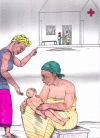Process and effects of a community intervention on malaria in rural Burkina Faso: randomized controlled trial
- PMID: 18364043
- PMCID: PMC2287184
- DOI: 10.1186/1475-2875-7-50
Process and effects of a community intervention on malaria in rural Burkina Faso: randomized controlled trial
Abstract
Background: In the rural areas of sub-Saharan Africa, the majority of young children affected by malaria have no access to formal health services. Home treatment through mothers of febrile children supported by mother groups and local health workers has the potential to reduce malaria morbidity and mortality.
Methods: A cluster-randomized controlled effectiveness trial was implemented from 2002-2004 in a malaria endemic area of rural Burkina Faso. Six and seven villages were randomly assigned to the intervention and control arms respectively. Febrile children from intervention villages were treated with chloroquine (CQ) by their mothers, supported by local women group leaders. CQ was regularly supplied through a revolving fund from local health centres. The trial was evaluated through two cross-sectional surveys at baseline and after two years of intervention. The primary endpoint of the study was the proportion of moderate to severe anaemia in children aged 6-59 months. For assessment of the development of drug efficacy over time, an in vivo CQ efficacy study was nested into the trial. The study is registered under http://www.controlled-trials.com (ISRCTN 34104704).
Results: The intervention was shown to be feasible under program conditions and a total of 1.076 children and 999 children were evaluated at baseline and follow-up time points respectively. Self-reported CQ treatment of fever episodes at home as well as referrals to health centres increased over the study period. At follow-up, CQ was detected in the blood of high proportions of intervention and control children. Compared to baseline findings, the prevalence of anaemia (29% vs 16%, p < 0.0001) and malaria parameters such as prevalence of P. falciparum parasitaemia, fever and palpable spleens was lower at follow-up but there were no differences between the intervention and control group. CQ efficacy decreased over the study period but this was not associated with the intervention.
Discussion: The decreasing prevalence of malaria morbidity including anaemia over the study period can be explained by an overall increase of malaria prevention and treatment activities in the study area. The lack of effectiveness of the intervention was likely caused by contamination, pre-existing differences in the coverage of malaria treatment in both study groups and an unexpectedly rapid increase of resistance against CQ, the first-line treatment drug at the time of the study.
Figures







References
-
- WHO World malaria situation in 1994. Wkly Epidemiol Rec. 1997;72:269–92. - PubMed
-
- Müller O, Traoré C, Kouyaté B, Becher H. Malaria morbidity, treatment seeking behaviour, and mortality in a cohort of young children in rural Burkina Faso. TM & IH. 2003;8:290–296. - PubMed
-
- Nsimba SED, Warsame M, Tomson G, Massele AY, Mbatiya ZA. A household survey of source, availability, and use of antimalarials in a rural area of Tanzania. Drug Information Journal. 1999;33:1025–32.
Publication types
MeSH terms
Substances
Associated data
LinkOut - more resources
Full Text Sources
Medical

